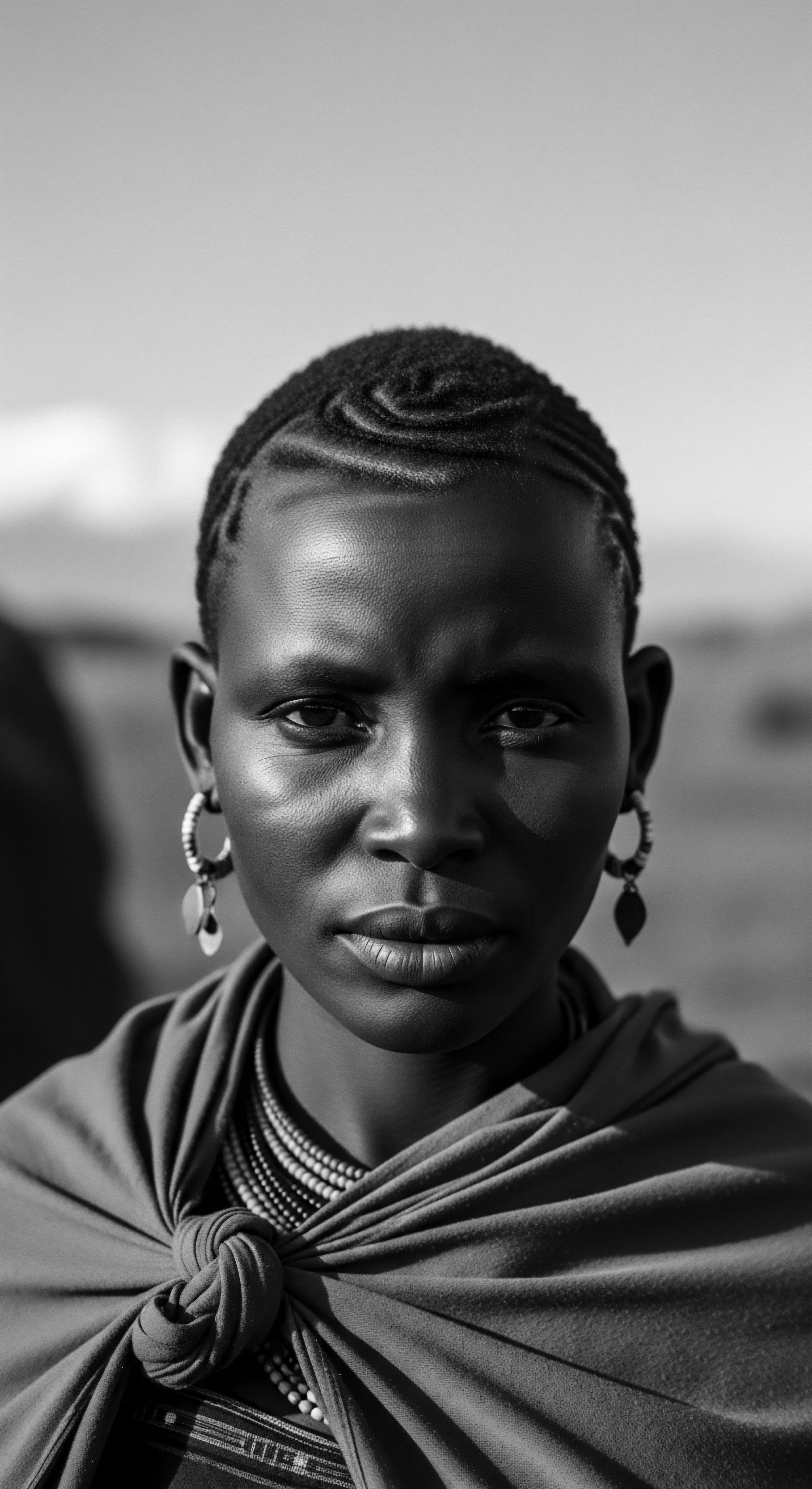
Fundamentals
The Ancestral Metal Arts, within the profound expanse of textured hair heritage, delineates the deliberate engagement with metallic elements as both adornment and functional instrument in the shaping, tending, and symbolic expression of coily, kinky, and wavy hair. It represents an ancient continuum of human ingenuity, particularly within African and diasporic communities, where the very act of adorning or grooming hair held deep significance, transcending mere aesthetics to speak of identity, status, and connection to ancestral ways. This foundational understanding considers how early peoples utilized metals not just for their gleam or malleability, but for the fundamental properties they bestowed upon hair practices.
At its core, the meaning of Ancestral Metal Arts speaks to the earliest known instances of metalworking influencing hair traditions. Archaeological records confirm the presence of hair adornments and tools crafted from various metals in antiquity. These discoveries offer a glimpse into a world where the earth’s minerals were not merely inert substances but dynamic components in daily rituals of personal presentation and community affiliation. The materials chosen—be they gold, copper, iron, or silver—each held distinct cultural and practical connotations, reflecting available resources, trade networks, and specific metallurgical skills passed through generations.

Early Implementations of Metal in Hair Culture
The earliest forms of Ancestral Metal Arts in hair often manifested as rudimentary tools, designed to navigate the unique characteristics of textured hair. Early combs, for instance, were crafted from a variety of materials, and metal emerged as a durable and sometimes adaptable option. These initial implements provided a means to detangle, separate, and style the dense, spiraling strands, a necessity given the inherent nature of coily hair, which is prone to tangling if not meticulously cared for. Such tools were not always refined or elaborate at first; their purpose was primarily practical, ensuring the hair remained manageable and in good condition, allowing for complex styles to be formed.
Alongside functional tools, metals quickly found their way into hair adornment, serving as tangible markers of social standing and communal identity. The act of placing metals within the hair elevated its presentation, transforming it into a living crown. This practice resonated deeply with the understanding that hair, often considered the highest point of the body, was a conduit for spiritual energy and a canvas for societal communication.

Material Choices and Their Context
- Gold ❉ In ancient Egypt, gold was reserved for royalty and elites. Gold combs, often elaborately designed, were used as decorative hair dresses, signifying nobility and familial heritage. Such pieces were not just worn; they were statements of immense wealth and a direct connection to divine power, frequently gracing the wigs and braids of the elite.
- Copper ❉ This metal, known for its malleability and distinctive color changes, held particular esteem among groups like the Dogon and Bambara of West Africa. Its use in adornment spoke to its unique properties and aesthetic appeal within specific cultural contexts, suggesting a deeper symbolic resonance.
- Silver ❉ Revered by the Amazigh (Berber) peoples of North Africa, silver was not merely a precious metal. It embodied values of humility, protection, and a profound connection to the natural world. Silver beads, known as Aggrab El-Fadda in Mauritania, were often tied into braided hair strands, representing fertility and prosperity.
These metals were chosen for their inherent qualities—their durability, luster, and symbolic associations. The application of these materials to hair practices underscores a sophisticated understanding of both metallurgy and the cultural significance of hair. It was a symbiosis, where the strength and beauty of the metal met the resilience and aesthetic potential of textured hair.

Intermediate
Moving beyond the fundamental applications, an intermediate understanding of Ancestral Metal Arts unveils a rich tapestry of symbolism, ritual, and adaptation woven into the very strands of textured hair heritage. Here, metal adornments and tools transcended their basic utility to become potent conveyors of meaning, deeply embedded in the social fabric and spiritual landscapes of African and diasporic communities. The meticulous placement of a metal ornament, the careful crafting of a metallic comb, each gesture held a story, a message, or a connection to a lineage of practices stretching back through time.
The significance of Ancestral Metal Arts extends into how societies communicated through coiffure. Hairstyles, frequently augmented with metal elements, functioned as visual languages, transmitting intricate details about an individual’s life. Marital status, age, tribal affiliation, wealth, and social rank were all discernible through the intricate designs and materials present in one’s hair. This form of non-verbal communication was particularly developed in West African societies, where hair was an outward expression of a person’s inner world and communal ties.
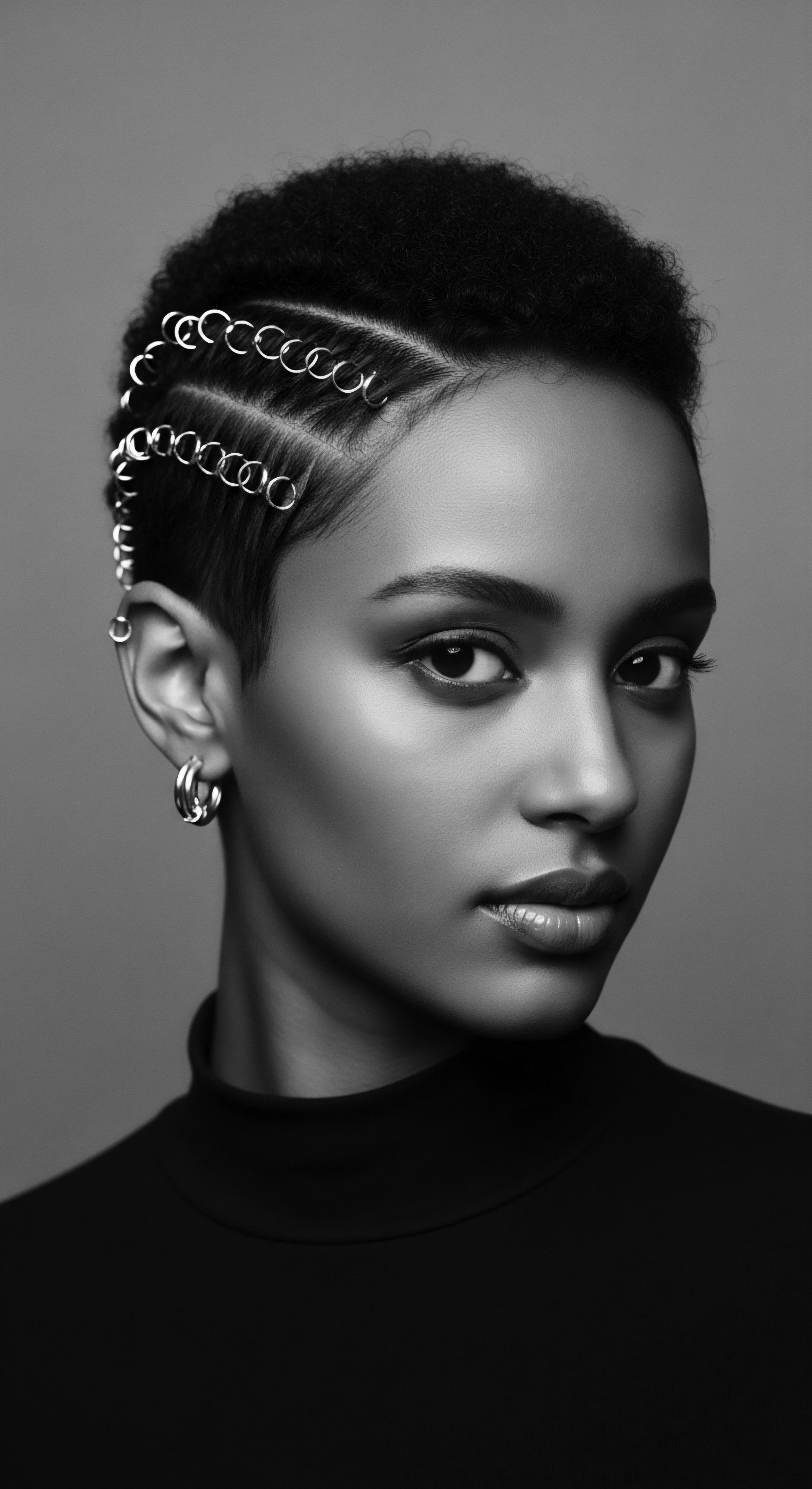
The Hair as a Communicative Medium
For instance, historical records from the 15th century indicate that within the Wolof tribe of modern-day Senegal and The Gambia, young women who were not yet eligible for marriage would partially shave their hair, a clear signal to bachelors about their availability. This demonstrates how hairstyles, and by extension, the tools and adornments used to create them, were integral to societal interactions. When men from the Wolof tribe went to war, they wore specific braided styles, embodying communal resolve.
Women in mourning adopted subdued hair arrangements, signifying their emotional state. These practices illustrate the profound role hair played as a living, dynamic canvas for communication.
Hair served as a visual language in many African societies, its styles and adornments, including metal elements, conveying complex information about identity and social standing.
In Ancient Egypt, the elaboration of wigs and headdresses, often adorned with gold and other precious materials, directly correlated with one’s social hierarchy and perceived connection to the divine. The more intricate and decorated the coiffure, the higher the individual’s standing. This connection between adornment and social power is a recurring motif across diverse African cultures, reinforcing that metal arts in hair were never merely superficial.

Regional Variations and Enduring Traditions
Across the diverse landscapes of Africa, the Ancestral Metal Arts adapted to local resources and cultural aesthetics, creating distinct regional expressions.
- Nubian/Kushite Influence ❉ In the Kingdom of Kush (modern-day Sudan), royalty, especially women, favored elaborate hairstyles incorporating braids and locs adorned with jewels, feathers, and metals. The Kushites held tightly coiled braids and metal-adorned headpieces in high regard, symbolizing both tribal identity and spiritual devotion.
- Berber Adornments ❉ The Amazigh (Berber) people of North Africa, from the Atlas Mountains to the Sahara, developed a unique tradition of silver jewelry. These pieces, often worn in the hair, were imbued with deep symbolic meaning related to protection and spirituality. Designs frequently included geometric shapes, the hand of Fatima (khamsa), and other talismans, reflecting a strong connection to nature and a sense of humility. Artisans meticulously engraved and molded silver into intricate patterns, a craft passed down through countless generations.
- West African Hair Artistry ❉ In various West African cultures, intricate braided and twisted locks, adorned with materials like beads, shells, and sometimes metal accents, were signature looks. These styles not only expressed creativity but also protected the hair from environmental elements. The Fulani people, a large nomadic community in West Africa and the Sahel, adorned their distinct braids with beads, shells, wooden elements, and even family silver coins or amber, linking directly to their heritage.
The Transatlantic Slave Trade profoundly disrupted these rich traditions. Enslaved Africans were often subjected to forced head shaving, a deliberate act designed to strip them of their cultural identity and sever ties to their ancestral lands. Yet, even under such dehumanizing conditions, the spirit of Ancestral Metal Arts persisted.
Deprived of their traditional tools, enslaved people resorted to ingenious methods, utilizing metal scraps—even those originally intended for grooming sheep—as makeshift combs and hair maintenance instruments. This stark reality underscores the deep-seated importance of hair care and adornment as an act of resistance and a quiet assertion of self, preserving a thread of heritage against immense odds.
| Culture/Region Ancient Egypt |
| Common Metal Adornments Gold combs, beads, and precious metal overlays on wigs. |
| Cultural/Symbolic Meaning Signified wealth, social hierarchy, and divine connection. |
| Culture/Region Kingdom of Kush (Nubia) |
| Common Metal Adornments Jewels, feathers, and various metals in braids and headpieces. |
| Cultural/Symbolic Meaning Expressed tribal identity, religious beliefs, and commitment to tradition. |
| Culture/Region Amazigh (Berber) Peoples |
| Common Metal Adornments Silver jewelry (khmissa, beads, fibulae) worn in hair. |
| Cultural/Symbolic Meaning Protection, spirituality, humility, connection to nature, prosperity. |
| Culture/Region West African Tribes (e.g. Fulani, Wolof) |
| Common Metal Adornments Metal accents, family silver coins, shells, and beads within braids. |
| Cultural/Symbolic Meaning Communication of age, marital status, tribal identity, wealth, and spiritual beliefs. |
| Culture/Region These examples reflect how Ancestral Metal Arts were deeply intertwined with the multifaceted expressions of identity and heritage across the African continent. |

Academic
The Ancestral Metal Arts constitute a complex interdisciplinary domain, situated at the confluence of material culture studies, ethno-archaeology, hair science, and the critical analysis of Black and mixed-race hair heritage. Its precise academic delineation recognizes the profound interaction between humanity’s earliest forays into metallurgy and the specific, often unique, properties of textured hair, extending beyond mere ornamentation to encompass functionality, socio-political commentary, and even latent biological considerations. The term encompasses not only the physical artifacts—the combs, pins, clasps, and decorative elements forged from iron, copper, bronze, gold, and silver—but also the dynamic practices, inherent meanings, and enduring legacies associated with their application to coily, kinky, and wavy hair structures across time and geography.
The meaning of Ancestral Metal Arts, when approached with academic rigor, is a testament to the ingenuity of early human societies in adapting available resources to address both practical needs and profound cultural expressions related to hair. Hair, in its biological essence, serves as a dynamic register of physiological and environmental interactions, and the introduction of metallic elements, whether as a tool or adornment, introduces a further layer of complexity to this biological substrate. The very act of combing or styling textured hair with metal instruments necessitates an understanding of its unique mechanical properties, its elasticity, tensile strength, and propensity for shrinkage and tangling. This historical interaction points to an intuitive, generational understanding of hair science long before modern scientific inquiry.

Echoes from the Source ❉ Elemental Biology and Ancient Practices
From a scientific perspective, the interaction of metals with hair, particularly textured hair rich in melanin, presents intriguing considerations. Melanin, the pigment responsible for hair color, is a complex biopolymer with known capabilities for chelating metal ions. While direct evidence of ancient peoples deliberately exploiting these biochemical interactions for hair care is scarce, the inherent presence of metals in their grooming practices—whether through the use of metal combs or the wearing of metallic adornments—meant a continuous, albeit unarticulated, engagement with these chemical possibilities. The luster of certain metals might have been observed to enhance the visual depth of dark, melanin-rich strands, an aesthetic appreciation grounded in an unwritten understanding of light reflection and absorption.
Furthermore, early metal tools, such as the rudimentary metal combs that emerged from contexts of scarcity, adapted their form to the unique structure of coily hair, allowing for effective detangling and styling without causing undue breakage. These tools, despite their simple construction, represent an early form of bio-material adaptation, where human hands shaped mineral resources to interface with the unique biomechanics of textured hair.
The Ancestral Metal Arts reveal how early societies intuitively understood and applied metallurgical properties to care for and adorn textured hair, a practice rooted in both practical necessity and profound cultural expression.

The Tender Thread ❉ Living Traditions of Care and Community
The sociological significance of Ancestral Metal Arts in hair culture is profound, particularly within the Black and mixed-race diaspora. Hair care, often a communal activity, became a critical site for the transmission of cultural knowledge and the reinforcement of social bonds. The sharing of specialized metal combs, the gifting of metallic adornments, and the communal experience of hair styling underscored a collective identity.
During periods of immense systemic oppression, such as the Transatlantic Slave Trade, these practices took on an even more potent meaning. Enslaved Africans, stripped of nearly all personal possessions and subjected to dehumanizing grooming practices, including forced head shaving, found resilience in adapting what little was available to maintain their hair.
A powerful illustration of this resilience and deep connection to Ancestral Metal Arts can be observed in the dire circumstances faced by enslaved individuals. Despite being denied access to personal belongings and clean water, they ingeniously repurposed materials. Historical accounts reveal that they resorted to using grease for hair lubrication and, crucially, utilized Metal Ornaments Originally Intended for Grooming Sheep as makeshift combs to tend to their hair. This specific historical example, documented in the continuing narrative of Black hair heritage, powerfully illuminates the profound determination to preserve dignity and a connection to self through hair care, even when traditional implements were brutally confiscated.
It speaks volumes about the human spirit’s capacity for adaptation and resistance, transforming instruments of animal husbandry into tools of self-preservation and a quiet act of cultural continuity. The very act of forming these crude metal tools for hair became a silent act of defiance, a tangible link to a heritage they were forbidden to openly express.
This instance is not merely anecdotal; it embodies a broader phenomenon of how enslaved communities across the diaspora creatively sustained ancestral hair practices, using whatever materials were available, including wood, bone, and metal scraps, to create combs and picks. This continuity of care, despite unimaginable duress, underscores the deep cultural and spiritual significance of hair itself.
The meaning of these practices reverberates into contemporary understandings of Black identity. The afro comb, in particular, with its deep roots in ancient African civilizations (dating back over 5,500 years with finds in Kush and Kemet), experienced a powerful resurgence in the 20th century. Initially carved from wood, bone, or ivory, it evolved to incorporate metal prongs, and famously, the “Black Power fist” emblem on its handle, transforming it into a political symbol of racial pride and resistance against Eurocentric beauty standards. This evolution from ancient tool to modern emblem encapsulates the enduring legacy of Ancestral Metal Arts as a vessel for cultural meaning and a statement of collective identity.
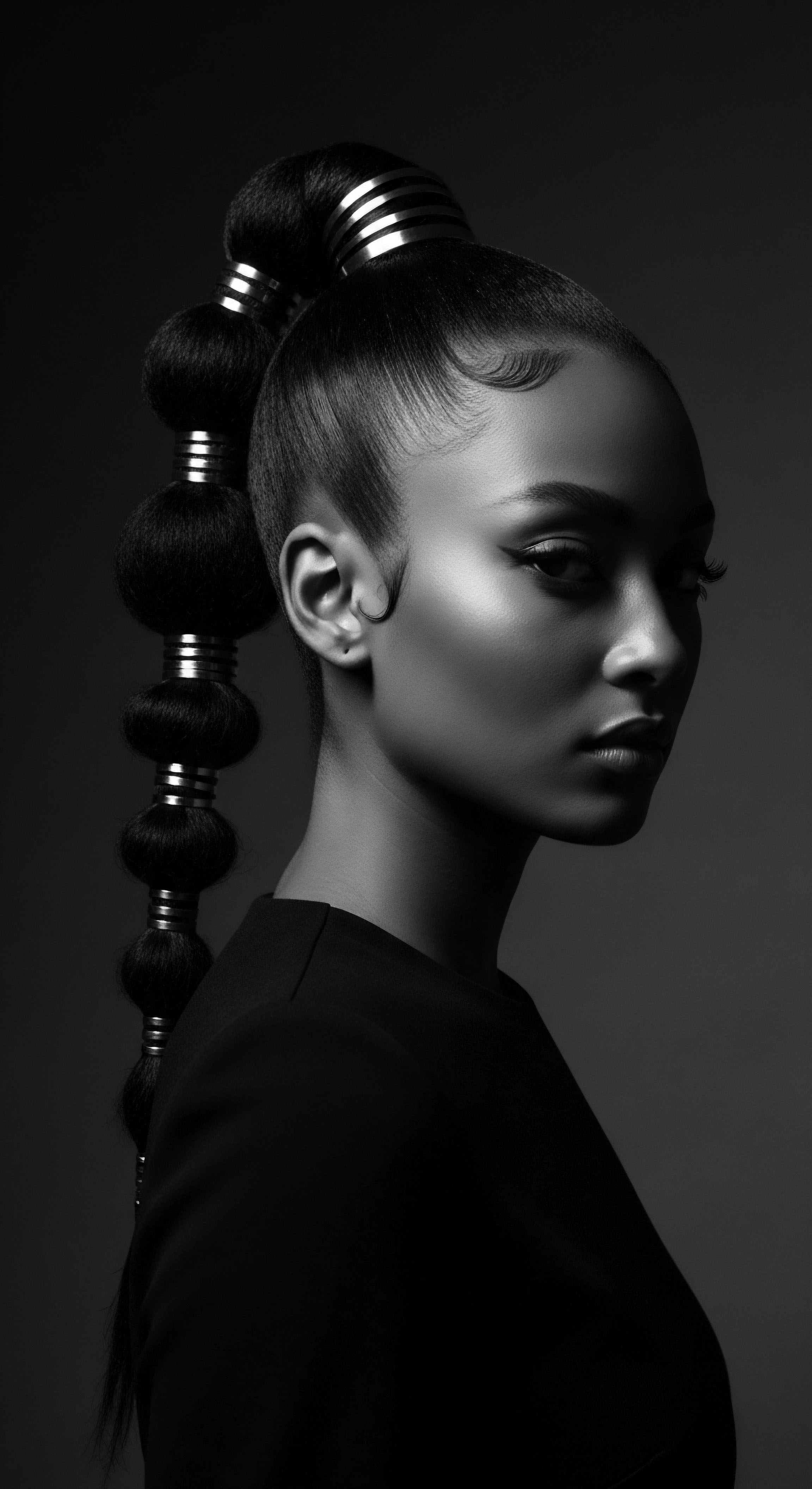
The Unbound Helix ❉ Voicing Identity and Shaping Futures
The academic analysis of Ancestral Metal Arts extends into semiotics and the anthropology of adornment, recognizing that these metallic elements are not merely static objects but dynamic signs within a complex cultural language. The choice of metal, its form, and its placement within a hairstyle transmit messages about the wearer’s beliefs, affiliations, and even their individual narrative journey. For example, the substantial silver fibulae of Berber women, often used to secure clothing but also serving as prominent head ornaments, are imbued with layers of symbolism related to protection, marital status, and a connection to ancestral lands. These pieces are often inherited, passing through generations, thereby embodying a genealogical continuity and a living archive of family history.
Furthermore, the academic lens compels us to consider the intersectional nature of hair, identity, and the Ancestral Metal Arts. Black hair is recognized as a profound transcript of gendered experience and a potent artifact of racial resistance. Policies historically targeting Black hairstyles, even prohibiting natural states, serve as bureaucratic violence and institutional attempts to enforce notions of cultural and racial superiority.
Within this context, the deliberate use of metal adornments and tools, particularly those carrying symbolic weight, becomes an active assertion of selfhood and a rejection of imposed narratives. It is an act of reclaiming agency over one’s own body and heritage.
The influence of Ancestral Metal Arts is observable in contemporary cultural expressions. Modern artists, designers, and even architects draw inspiration from traditional Black hair practices, including the use of adornment, to inform new creations. For example, research projects explore how the intricate structures and meanings embedded in Black hairstyles can inspire innovative building materials and computational design, seeing hair as a powerful enduring signifier of Black identity. This scholarly engagement with the historical and ongoing relevance of Ancestral Metal Arts demonstrates its continued capacity to shape artistic expression, cultural discourse, and even future material innovations, solidifying its place as a critical area of study within the broader humanities and sciences.
The academic definition of Ancestral Metal Arts thus moves beyond a simplistic descriptive account. It is an elucidation of how early metallurgical innovations intersected with the unique demands and cultural values surrounding textured hair, leading to a rich legacy of tools and adornments. This legacy persisted through historical traumas, adapted to new environments, and continues to influence contemporary identity. The ongoing study of these practices, through the rigorous application of anthropological, historical, and scientific methodologies, continually deepens our appreciation for the complex relationship between material culture, human biology, and the enduring spirit of heritage.
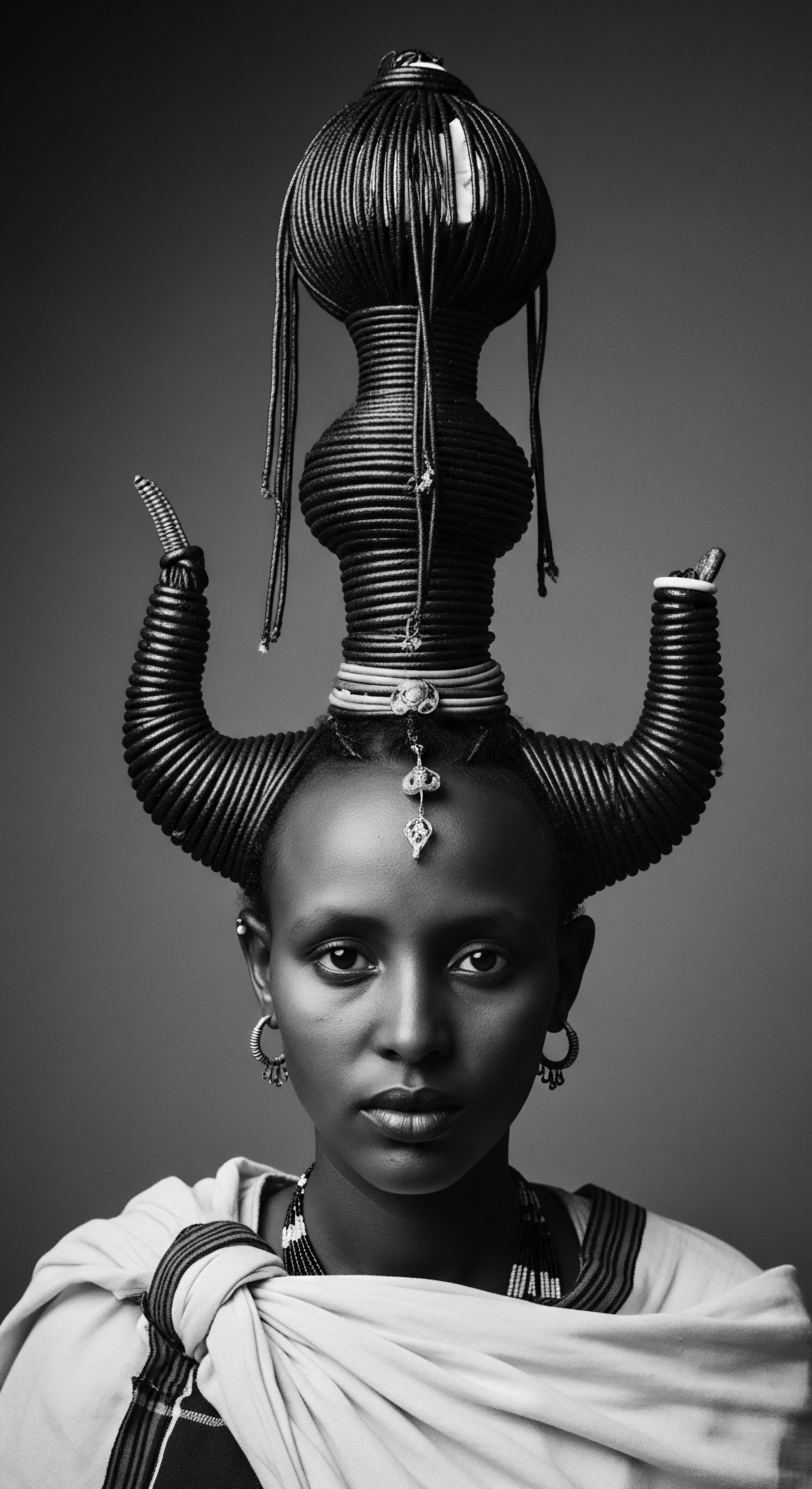
Reflection on the Heritage of Ancestral Metal Arts
The exploration of Ancestral Metal Arts is a journey into the deepest reservoirs of human heritage, particularly for those whose roots lie in textured hair traditions. It is more than a historical recount; it stands as a resonant affirmation of ingenuity, resilience, and the profound connection between material culture and the very fiber of identity. From the elemental biology of melanin-rich strands to the tender, communal acts of care, and onward to the unbound expressions of self, the legacy of metal in hair reflects a continuous conversation between past and present.

Echoes from the Source ❉ The Genesis of Connection
In the genesis of this connection, we discern the “Echoes from the Source,” a whispering remembrance of when the earth’s raw metals first met the human hand, guided by an innate understanding of hair’s unique demands. Early metal tools, forged from necessity, facilitated the care of coily and kinky textures, allowing for the meticulous division of strands for braiding or twisting, safeguarding delicate coils from breakage. This early application speaks to an intuitive, practical relationship with metal, rooted in the elemental needs of maintaining hair health in diverse climates and environments. The metallic gleam, perhaps, was initially a secondary delight, yet it soon became interwoven with symbolic meaning, marking passages of life and expressions of communal belonging.
The Ancestral Metal Arts serve as a luminous testament to humanity’s deep-rooted connection to hair, intertwining ancient craftsmanship with enduring cultural identity.

The Tender Thread ❉ Sustaining Community Through Care
The practice of Ancestral Metal Arts extended into the “Tender Thread” of living traditions of care and community. Hair rituals, often conducted within intimate circles, became vessels for transmitting ancestral knowledge, stories, and shared values. The tools and adornments themselves, perhaps passed down through generations, became tangible links to those who came before, embodying the collective wisdom of a lineage. The communal aspect of hair styling, where metal combs might have been shared and metallic beads meticulously threaded onto braids, reinforced social bonds and provided spaces for intergenerational learning and emotional sustenance.
Even through periods of extreme hardship, such as the brutal disruptions of enslavement, the determination to retain these practices, even with repurposed metal scraps, highlights the profound role of hair care in upholding dignity and connection to one’s roots. This enduring resilience is a poignant reminder of hair’s spiritual and psychological significance, a sacred part of self and heritage that defies oppression.

The Unbound Helix ❉ Identity, Resistance, and Future Expressions
Today, the influence of Ancestral Metal Arts continues to shape the “Unbound Helix” of identity and future expressions. It stands as a powerful reminder that hair is not merely a biological appendage; it is a canvas of cultural memory, a symbol of resistance, and a dynamic medium for self-determination. For Black and mixed-race individuals, the legacy of these metal arts intertwines with the ongoing journey of embracing natural hair textures and reclaiming narratives around beauty. The contemporary resurgence of natural hair movements, often echoing the pride symbolized by the Afro pick, itself a modern iteration with metallic prongs, demonstrates a conscious return to ancestral aesthetics and a celebration of the hair that grows from the scalp.
The artistry, the symbolism, and the sheer fortitude embedded in the Ancestral Metal Arts invite us to view our own hair journeys through a lens of profound respect and historical awareness. They encourage us to recognize that every strand carries echoes of elemental biology, tender communal care, and an unyielding spirit of self-expression, inviting us to celebrate the unique heritage of our own hair with deep reverence and joyful affirmation.
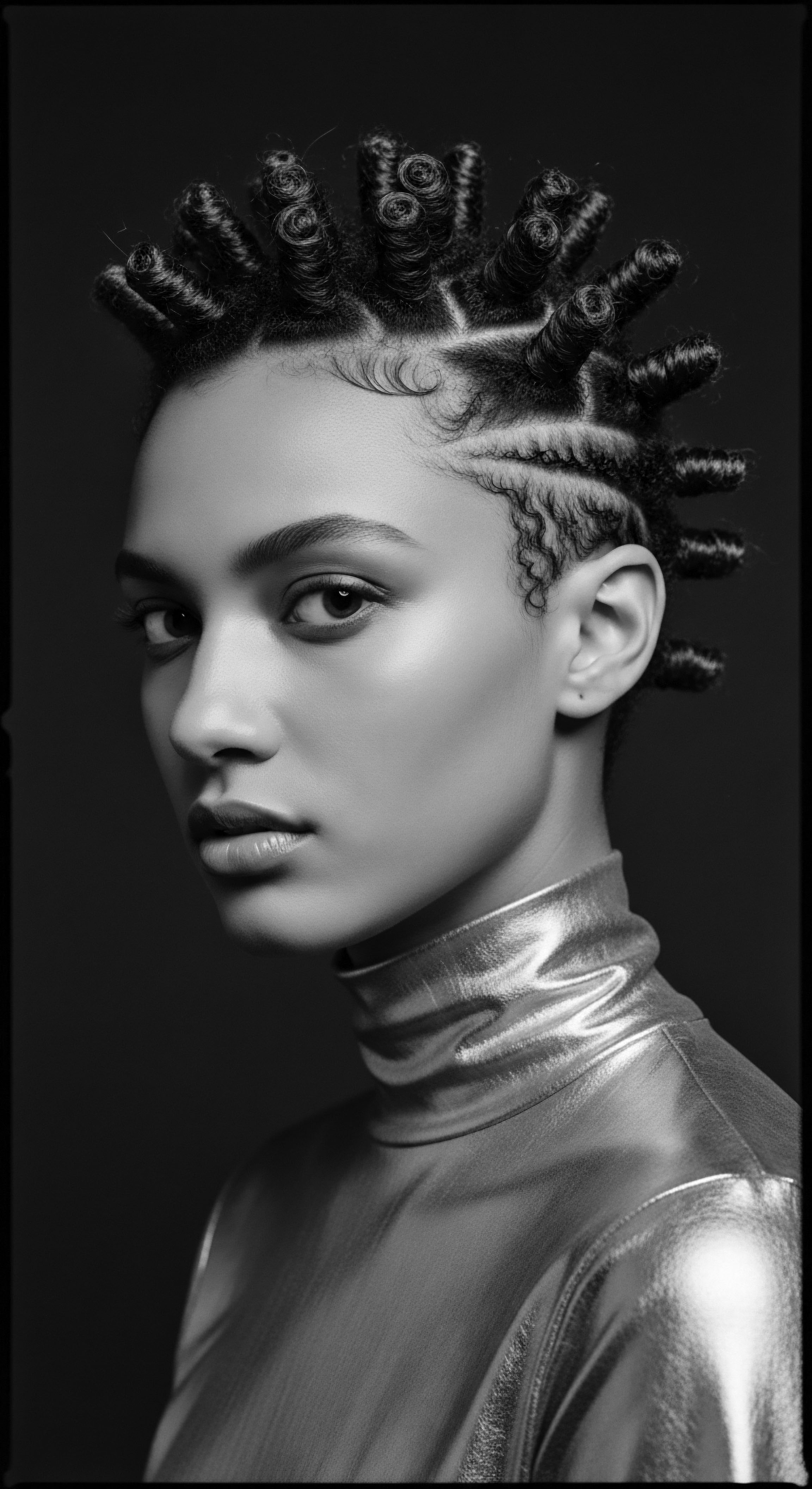
References
- Byrd, A. and Tharps, L. (2001). Hair Story ❉ Untangling the Roots of Black Hair in America. St. Martin’s Press.
- Cobb, J. (2022). Black Hair ❉ A History of an American Icon. One World.
- DeGruy, J. (2005). Post Traumatic Slave Syndrome ❉ America’s Legacy of Enduring Injury and Healing. Uptone Press.
- Ellington, T. (2018). Natural Hair. (Unpublished paper).
- Gates, H. L. Jr. (Ed.). (1984). Black Literature and Literary Theory. Methuen & Co, Ltd.
- Murdock, G. P. (1945). The Common Denominator of Cultures. Scientific American, 173(4), 1-13.
- Sieber, R. and Herreman, F. (2000). Hair in African Art and Culture. Museum for African Art.
- Tulloch, C. (2008). Resounding power of the Afro comb. In G. Biddle-Perry and S. Cheang (Eds.), Hair Styling Culture and Fashion (pp. 128-139).
- Wahlman, M. S. (2001). Signs and Symbols ❉ African Images in African-American Quilts. The Museum of American Folk Art.
